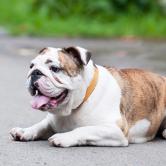How to Protect Your Bulldog Against Heat Stroke

Everyone knows that the Bulldog breed has a large, compressed head and wrinkled skin. What many people do not realize, however, is that the same physical traits that make the Bulldog so identifiable are the ones that put his health at risk. Bulldogs are a brachycephalic breed which automatically puts them at a higher risk for exercise- or heat-induced health problems. Keep reading to learn more about brachycephalic syndrome and how it increases your dog’s risk for heat stroke.
What is Brachycephalic Syndrome?
Also known as brachycephalic airway syndrome, brachycephalic syndrome in dogs is a group of anatomical abnormalities in the upper airway that can constrict your dog’s breathing. The four main abnormalities included in this syndrome are:
· Elongated Soft Palate – This is a soft palate (the soft tissue on the roof of the mouth) that is so long that it sometimes collapses into the airway.
· Stenotic Nares – These are simply small or narrowed nostrils and they can restrict the amount of air that flows in through the nostrils.
· Hypoplastic Trachea – This is an abnormality characterized by a trachea that is smaller in diameter than is normal.
· Everted Laryngeal Saccules – these are small pouches in the larynx which are sucked into the airway, obstructing air flow.
Bulldogs can be affected by one, some, or all of these abnormalities and they can restrict his breathing to the point where excessive heat or strenuous exercise can actually become dangerous. If your dog isn’t able to take in enough air, his blood won’t be properly oxygenated and that can cause the organs and systems in his body to shut down.
Identifying and Treating Heat Stroke in Bulldogs
Heat stroke is an extremely serious and sometimes fatal condition – it occurs when your dog’s internal temperature rises to a dangerously high level (above 103°F). Some of the signs and symptoms of heat stroke in dogs include the following:
· Excessive panting
· Drooling
· Reddened or pale gums
· Rapid heart rate
· Irregular heart beat
· Vomiting blood
· Changes in mental status
· Seizures
· Muscle tremors
· Loss of consciousness
At the first sign of heat stroke, you need to take immediate action to cool your Bulldog down. Do not, however, throw him in a bath of ice water – lowering his body temperature too quickly can be equally dangerous. The best thing you can do is drape a cool wet towel over his back and have him stand in a tub or pool filled with a few inches of cool water. Pointing a fan at your dog will facilitate air movement that might also help him to cool down. Take your dog’s temperature every 5 minutes until it goes below 103°F – when it does, stop cooling measures and dry your dog off before taking him to the vet.
The Bulldog is a wonderful breed but these dogs do have some unique requirements. If you plan to keep a Bulldog, be sure that he has access to shade and fresh water when he is outside. It is also a good idea to help him maintain a healthy bodyweight and, when you exercise him, do so in the cooler hours of the morning or evening.







